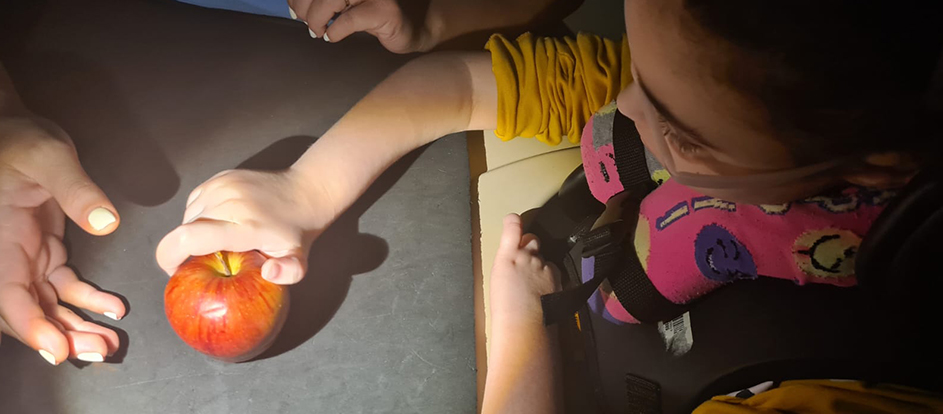April is Cortical Visual impairment (CVI) Literacy Awareness Month. The road to literacy is different for someone with CVI than someone with a different type of vision impairment. The eyes of individuals with CVI are healthy and see what everyone else sees, however, the brain has difficulty comprehending, recognizing, and interpreting what the eyes catches.
CVI Range’s Effects on Literacy
Children with CVI receive an entirely different literacy education than children with ocular visual impairments. For example, enlarging the text, placing the text under a video magnifier, making a braille transcription of it, or providing an additional audio version of it. It is crucial to understand the child’s level of visual functioning and how particular behavioral traits affect them.
With proper assessment results and careful consideration of each child’s particular preferences and needs, a collection of books can be built that encourages looking behavior, interaction, interest, and the development of pre-literacy skills. We must take the child’s interests into consideration when creating the books to make reading enjoyable.
Literacy in CVI
“Literacy begins when they look” – Christine Roman-Lantzy.
It is important for parents of children with CVI to understand that when literacy is discussed, it does not only specify those who are in Phase III (Christine Roman) but rather all children with CVI are included.
The CVI Range assessment was developed by Dr. Christine Roman-Lantzy to investigate the visual and behavioral characteristics associated with CVI to provide appropriate intervention by clinicians. The results of CVI Range are categorized into 3 main phases: Phase I, Phase II and Phase III.
In Phase I, children with CVI make use of their vision and develop visual skills. It is rare for an individual in Phase I to have direct eye-to-object visual skills (directly looking at a visual target). Rather, a “look, look away” pattern can be observed at this phase. Therefore, the goal is building consistent visual behavior.
Giving children with CVI the chance to look gives them the opportunity to develop and use their vision. Preliteracy and literacy activities must be interesting for a child to show excitement in reading books. It is best to start by learning the child’s preferred visual target. Parents are usually the ones with the expertise in this area. They are aware of the child’s preferred targets and items, and they frequently use the actual, concrete object or a representation of it in a book. Additionally, it’s crucial to comprehend the child’s preferred color and link it to or with the preferred object, particularly if they have Phase I visual functioning.

In Phase II, the goal is integrating vision with function. The individual now has enough consistent visual behavior to look at objects, reach for a desired object, or use gaze to indicate a want or need.
Therefore, the objective is to promote the use of vision to make an impact. Interventions and adaptations based on the CVI characteristics must be incorporated systematically throughout the child’s day to provide visual access. In addition to creating activities that require vision to accomplish a task, such as reaching for an item needed in a self-care routine.
In Phase III, the child gains the ability to distinguish between different details and starts learning letters and sight words. The goal of therapy is to refine the CVI characteristics, identify the salient features, and discriminate targets against a complex background.
Salient features are the defining elements that distinguish one target from another. By describing the distinctive features of the target, the child easily distinguishes it from the surroundings or the background. The ability to identify and recognize salient features of objects are a prerequisite to learning letters and sight words for a child with CVI. When a child can distinguish between a dog and a cat, between a “b” and a “d” and when they can name the distinguishing characteristics, then they are prepared. Hence, letters, sight words, or reading is not introduced until Phase III.
Building a foundation for literacy development
A progression of skills when teaching literacy includes beginning with the use of objects and moves to 2D materials, the incorporation of salient visual features and comparative thought, and the use of symbolic systems.


Strategies to consider for CVI based literacy activities:
- Color preference
- Delayed responses when looking
- Declutter – Concentrating can be exhausting!
- Ensuring that the visual stimulus / object is presented in the optimal visual area
- Use a high contrast background
- Objects/pictures/letters/words need to be close
- Avoiding too many distractors around
Getting Started
- Use real objects to establish connection to words
- Make 3D books
- Black background (can be soft or hard materials)
- Position words with objects in books (use Velcro – or similar – to remove, handle and then replace)
Next Steps
- Try 2D pictures in books
- Try squashing an object then insert it into a book
- Create the shape around it leaving only the shape e.g. leaf, flower
- Using a raised outline will help to identify the shape (try wiki-stiks or similar)
- Words should be alongside the 2D pictures
- Keep it simple!
Simple books: Strategy: Reduced complexity

- A single shape
- Shiny paper
- Plain, black background
- Slight variations in color, placement, and number
- Create books from the child’s own experiences using concrete materials that the child has touched during the activity.
- Real objects are much easier to relate to than pictures.
Creating tactile books or books with objects


Matching objects and pictures
Understanding that pictures, symbols, and letters are representations of the real world.
Teaching Salient features
Sight words are more visually accessible when presented as a single-shaped form. They are essentially memorized as whole shapes with salient visual features.

All children with CVI should participate in a comprehensive literacy program. They need the same opportunities to develop literacy skills demonstrated in an assessment-oriented manner. Literacy includes understanding symbols regardless of their form. For children with CVI, it could be objects, drawings, photographs, tactile symbols, braille printing, and others. Children with CVI learn more concepts as they interact with the world around them in familiar ways. They can start giving meaning to words and their world.
Always remember that literacy is dynamic, multisensory, and constantly evolving.
If you have any concerns about your child’s vision, please contact our vision therapist, Ms. Maisa Obeid, and the Occupational Therapy team at High Hopes. We are happy to answer any questions you may have.




